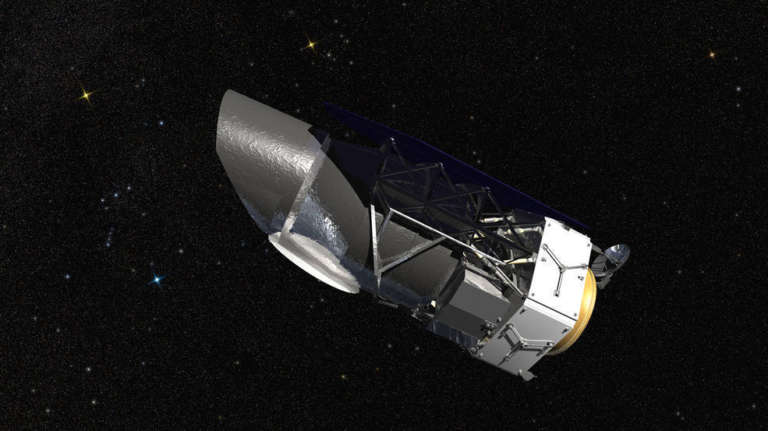Jason Rhodes • Aug 10, 2016
The Many Names of WFIRST
Many NASA missions and projects have become household names – Apollo, Hubble, and, more recently, Curiosity. These names are chosen with care, and the names themselves can change over the course of a project, from inception to completion. Tracking the changing names of a project can reveal the story of a mission's development. NASA’s next big “flagship” astronomy mission, following the ambitious James Webb Space Telescope due to be launched in 2018, is currently known as the Wide Field Infrared Survey Telescope (WFIRST). When NASA formally committed to flying WFIRST in February 2016, news stories stated that NASA had then "begun" work on WFIRST. This amused me because I, along with many of my colleagues, had already put hundreds of collective work-years into the development of WFIRST, under a slew of different names.

I wrote about WFIRST’s ambitious science goals (dark energy, exoplanets, and infrared sky surveys) for The Planetary Report last year. Teams of scientists have been proposing missions to accomplish subsets of these goals for many years. Let’s start with one of WFIRST’s primary science goals: to detect exoplanets by the use of microlensing. Although the technique can be used by ground-based telescopes, microlensing works best above the blurring effects of the atmosphere. Back in 2000, David Bennett (then at Notre Dame and now at NASA’s Goddard Space Flight Center working on WFIRST) proposed a satellite called the Galactic Exoplanet Survey Telescope (GEST) to do microlensing. GEST represented my first foray into space mission development, since I was a co-investigator on the GEST proposal. I proposed to use part of GEST’s time not to study exoplanets but instead to study dark energy. Thus, GEST was also an early harbinger of the idea of using a single telescope to explore both exoplanets and dark energy. While GEST was not selected, Bennett’s mission concept survived, and developed over the following decade into the Microlensing Planet Finder (MPF) mission concept, which was submitted to the 2010 Astronomy & Astrophysics Decadal Survey, in which the astronomy community ranks mission priorities.
Actually, the dark energy component of WFIRST originated in multiple mission proposals. Soon after the discovery of dark energy in 1998, Saul Perlmutter (who went on to win a 2011 Nobel Prize for that discovery) and his colleague Michael Levi at the Lawrence Berkeley National Laboratory developed the concept for a space mission to study dark energy: the Supernova Acceleration Probe (SNAP). I joined the SNAP team in 2001 and helped to expand the scope of SNAP from supernovae to multiple techniques for studying dark energy. SNAP was a Department of Energy-led project but NASA, of course, has an interest in studying dark energy as well. Eventually NASA and the Department of Energy got together and planned to jointly build a mission they dubbed the Joint Dark Energy Mission (JDEM); this mission was led by Neil Gehrels at NASA GSFC, now the WFIRST Project Scientist. Astute fans of Marvel’s Avengers movie may recognize JDEM as the name of the facility that Loki destroys at the beginning of the movie. Alas, Loki was too late, because JDEM had already been subsumed into WFIRST by the time the movie came out in 2012!
The excitement surrounding the discovery of dark energy, and the potential for a multi-agency mission, compelled multiple groups to come up with competing mission ideas for the JDEM concept, so SNAP was not the only game in town. Chuck Bennett at Johns Hopkins led the Advanced Dark Energy Physics Telescope (ADEPT) team; Tod Lauer at the National Optical Astronomy Observatory led the Dark Energy Space Telescope (Destiny) team; and Yun Wang—then at the University of Oklahoma and now at Caltech/JPL working on WFIRST—had the most exciting name for a mission to study a mysterious force that controls the fate of the Universe: the Joint Efficient Dark Energy Investigation (JEDI). For a brief time, NASA and the European Space Agency (ESA) also tried to merge their dark energy mission concepts. The JDEM and ESA Euclid missions had a trial marriage as the International Dark Energy Cosmology Surveyor (IDECS), but they separated amicably; NASA is a partner on Euclid (with me as the NASA representative) and ESA is in advanced negotiations to join WFIRST.
The last main mission goal of WFIRST is to perform infrared surveys of the sky. There have been many mission concepts that proposed to do such surveys. However, the one that fed directly into the formation of WFIRST via the 2010 Decadal Survey was proposed by Daniel Stern at JPL. Daniel briefly flirted with the name Near-Infrared Deep Sky Survey (NIRDSS). Perhaps this name struck too close to home for those of us who dedicated our lives to science, and the more sedate Near Infrared Sky Surveyor (NIRSS) was chosen.
Ultimately, the 2010 Decadal Survey combined NIRSS, MPF, and JDEM into WFIRST, and a dedicated group of people has been carrying the concept forward for 6 years to become a real NASA mission. WFIRST will have one more name change before it is launched (or soon after), and that name will be the one that is remembered in the history books. NASA will likely choose to name this powerful satellite after a pioneering scientist or other illustrious figure from history. I am partial to the name Sagan, given WFIRST’s role in advancing our understanding of the Universe, inspiring future generations of astronomers, and progressing on our quest to find another pale blue dot like home.
The Time is Now.
As a Planetary Defender, you’re part of our mission to decrease the risk of Earth being hit by an asteroid or comet.
Donate Today

 Explore Worlds
Explore Worlds Find Life
Find Life Defend Earth
Defend Earth

